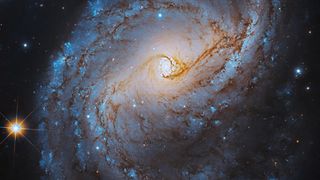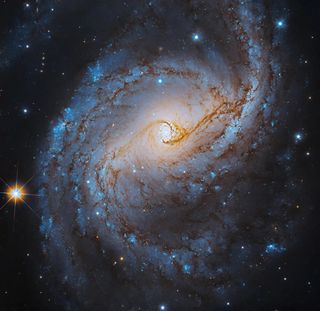This Hubble Telescope view of a chalky spiral galaxy is a sight to behold (photo)
It's like staring directly into a different world we can never physically explore.

No matter how many galaxy images the Hubble Space Telescope procures, there really is no diminishing return. And there's something about the observatory's latest muse, a realm known as NGC 6951, that feels particularly lovely. I'm not sure whether it's the angle — we're looking straight into its heart — or the opaque haze emanating from the center that reminds me of blotted chalk.
Either way, this galaxy, which lies 78 million light years from Earth and is75,000 light years wide,y is a work of art. Even a statement NASA released in accompaniment with the image describes it as having bright blue spiral arms, pinpricks of star clusters and trails of dark orange dust. Some of that dust sort of cuts across the spiral structure, like bars, which earns NGC 6951 the fitting classification of "barred spiral galaxy." Those "bars" can be thought of as fertile soil for birthing stars.
"Spiral lanes of dust, shown in dark orange, connect the center of the galaxy to its outer regions, contributing more material for future star formation," the release says.
The newly released photo was constructed with data in both visible and infrared light from Hubble's Wide Field Camera 3 (WFC3) and Advanced Camera for Surveys (ACS). Fascinatingly, WFC3 was installed on the observatory in 2009 during a servicing mission by astronauts, who physically went to Hubble in orbit and tinkered with its equipment. ACS was stationed on Hubble in a similar way as an upgrade to replace the telescope's original Faint Object Camera. And because of such efforts, we have the image we see today!
Related: Hubble Telescope reveals a rare galaxy with a luminous heart (photo)
The history of this galaxy is quite interesting as well; NASA explains that NGC 6951 experienced its highest rates of star formation about 800 million years ago (that's way before the dinosaurs) but then halted those stellar births for 300 million years. Then, the star factory started up again. Plus, some of those stars died with a bang, undergoing immense supernova explosions. It's believed that six of those major eruptions actually occurred within the past 25 years.
"The average age of a star cluster, or gravitationally bound group of stars, in this galaxy is 200 to 300 million years old, though some are as old as one billion years," the release states. "Turbulent regions of gas, shown in dark red, surround the bright blue pinpricks that are star clusters."
Get the Space.com Newsletter
Breaking space news, the latest updates on rocket launches, skywatching events and more!
NGC 6951 is formally classified as a Type II Seyfert galaxy — another recently released Hubble image is of this kind as well — which means it emits lots of infrared radiation and possesses slow-moving gaseous matter at its center, the release says. However, "some astronomers classify NGC 6951 as a low-ionization nuclear emission-line region (LINER) galaxy," it adds, "which is similar to a Type II Seyfert galaxy but with a cooler nucleus that emits weakly ionized or neutral atoms like oxygen, nitrogen and sulfur. "

It's also worth bringing your attention to the center of the image, where NGC 6951's supermassive black hole can be inferred to reside. That black hole, scientists say, is surrounded by a ring of stars, gas and dust about 3,700 light-years across. This ring is expected to have been forming stars for between 1 and 1.5 billion years, but 40% of its mass is thought to have stars less than 100 million years old. It's called a "circumnuclear ring."
The NGC 6951 photo is part of a NASA Hubble image release campaign, during which a new image taken by the observatory will be unveiled each day between Oct. 2 and Oct. 7.
Join our Space Forums to keep talking space on the latest missions, night sky and more! And if you have a news tip, correction or comment, let us know at: community@space.com.

Monisha Ravisetti is Space.com's Astronomy Editor. She covers black holes, star explosions, gravitational waves, exoplanet discoveries and other enigmas hidden across the fabric of space and time. Previously, she was a science writer at CNET, and before that, reported for The Academic Times. Prior to becoming a writer, she was an immunology researcher at Weill Cornell Medical Center in New York. She graduated from New York University in 2018 with a B.A. in philosophy, physics and chemistry. She spends too much time playing online chess. Her favorite planet is Earth.
